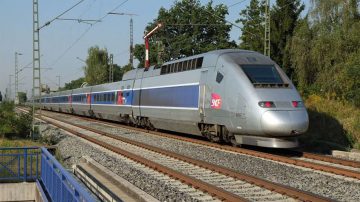
Conditions remain challenging for Europe’s rail operators but new night services and rail-air links will provide welcome momentum, reports Alex McWhirter.
As I write these words, much uncertainty remains about European rail travel. Although operators continue to run their revised schedules, passenger numbers remain low owing to pandemic restrictions. Still, some positive developments are appearing in mainland Europe.
First, let’s look at the Eurostar situation. In winter, when the high-speed operator was reduced to operating a sparse schedule, the situation was dire and the chief executives of both Eurostar and HS1 – the high-speed link between London and Folkestone – stated that their operations might fail.
Late last year, Eurostar’s schedules were reduced to a single daily service to both Amsterdam and Paris, with no dedicated route to Brussels, which instead became a mere stop on the London-Amsterdam route. Never have I known Eurostar to provide such a limited operation. At the time of writing in mid-April, the core schedule remains exactly the same.
The problem for Eurostar is that, as we went to press, all of its destinations were affected by either lockdowns, quarantine restrictions or the need for PCR tests. In addition, pre-Covid-19 it was taking more and more travellers beyond Brussels and Paris to Germany, Switzerland, Italy and Spain. Such travel is more difficult, if not impossible, at the time of writing.
OUT OF THE DARKNESS
So what’s the positive rail news? The biggest developments are the rebirth of night trains plus rail-air expansion. In recent years, two main operators, Germany’s Deutsche Bahn (DB) and France’s SNCF, have either axed or severely reduced their night sleepers. Fortunately, Austria’s OEBB took over a few of DB’s former night trains and placed them under its Nightjet banner.
Now there are plans for major expansion, with OEBB planning more Nightjet services out of Switzerland, including a new link from Zurich to Amsterdam via Frankfurt and Cologne.
At the same time, a new generation of state-of-the-art Nightjet stock was unveiled in Vienna in February. Service entry is planned for December 2022 and initial routes will be from Vienna and Munich to Italy, covering destinations such as Milan, Venice and Rome.
The advantage of these new trains is the provision of many more single-berth compartments that will be priced more economically than today’s counterparts. As we all know, single compartments are ideal in the Covid era.
The EU’s green agenda means it favours rail travel and 2021 has been designated the European Year of Rail, so it comes as no surprise to learn that night services are being expanded along with rail-air links.
OEBB will operate the planned night routes, which are to be relaunched over the coming few years. The first two, Zurich-Cologne-Amsterdam and Vienna-Munich-Paris, will start in December this year, to be followed in December 2022 by Zurich-Rome and in December 2023 by Berlin-Paris and Berlin-Brussels. December 2024 will then see the launch of Zurich-Barcelona. Funding for these services is being provided by the state-owned rail operators of France, Germany, Austria and Switzerland.
Why might night trains require state support? It’s because their profitability varies owing to several factors. In the UK, for example, the Caledonian Sleeper requires government subsidies as its services remain loss-making.
Factors that make overnight trains costly to operate include poor rolling stock utilisation, low passenger count and a high staff-to-customer ratio compared with daytime trains. Routes can also be much more complex than a simple air journey – taking the Nightjet from Vienna to Berlin, for example, involves transiting through several countries.
RAIL-AIR RAMPS UP
Rail-air connections are now established at most hub airports in mainland Europe. France, along with Germany, is a leader in rail-air – its SNCF link, which operates TGV trains to Paris Charles de Gaulle from domestic points in France along with Brussels, is light years ahead of anything the UK can offer and allows you to book your flight and train at the same time.
The Netherlands’ KLM is now considering launching rail-air routes to Schiphol from the likes of Brussels, Paris and Dusseldorf. KLM can be accused of being a rail-air “laggard” because it majors on sixth-freedom or transfer traffic. As transfer traffic is vital to the airline’s success, it prefers to control customers throughout their journey rather than rely on rail operators, some of which may be located outside of the home country.
Lufthansa and Deutsche Bahn, meanwhile, will be expanding their cooperation in the coming months – from July they will offer rail-air connections to Frankfurt from both Hamburg and Munich, while December will see the addition of a Frankfurt-Berlin link among others.
These ambitious rail-air plans centre around Lufthansa’s Frankfurt hub rather than its second hub at Munich because the latter airport is not directly connected to DB’s mainline network.
Not to be overlooked are Swiss and Austrian Airlines, together with their nations’ rail systems. Austrian, like Swiss, now applies its flight codes to its rail-air connections, with most domestic flights axed. Austrian has acted in this way partly because rail offers a green alternative but also because it was a condition of receiving e600 million in state aid.
Further developments are awaited with interest.












